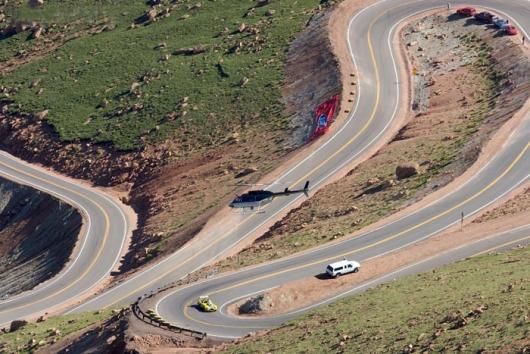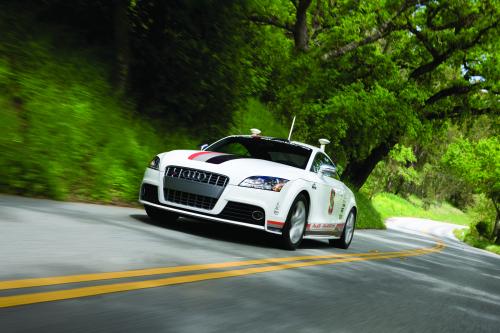Autonomous Audi TTS overcomes the race track at speeds up to 72 km / h
A few days ago, Audi proudly announced that the Audi TTS autonomous car had conquered Pikes Peak, a steep mountain in Colorado. The average slope of the track is 7%, and the steepness of the turns has become legendary among motorsport fans.

Unlike all previous experiments with autonomous cars, the developers of the Audi TTS robot set the goal is not driving safety, but maximum speed.
A 20-kilometer track to the summit with 156 turns - a traditional venue for racing driverswho come here since 1994. Robot Audi TTS was able to call on the mountain in 27 minutes. Objectively speaking, this is a weak result. Among professional race drivers, the track record is 10: 01,408. It was installed on July 21, 2007 by Japanese racing driver Nobuhiro Monster Tajima in a Suzuki Sport XL7.
In fairness, we note that the power of race cars in competitions is approaching 900 hp, while the Audi TTS has only 265 hp. According to experts, in a car of this class, the best human driver could not climb a mountain faster than 17 minutes.

In reality, the Audi TTS climb to Pikes Peak took place in September, they just reported it only now.
The maximum speed of the robot car did not exceed 72.5 km / h. However, this is only the beginning. Surely not far off is the time when artificial intelligence will overtake manned cars on well-known tracks. In computer simulations, they do this - the computer is able to calculate the ideal trajectory and adhere to it 100%, while absolutely controlling all the characteristics of the chassis in real time.
Of course, in order for the robot to overtake a person, all parameters and angles of each rotation must be loaded in advance with an accuracy of a centimeter, the ideal trajectory with different conditions of adhesion to the track must be calculated in advance, etc. If during the race it rains or the pressure in the wheel drops, no supercomputer can recalculate its programs.
On the other hand, the stand-alone Audi TTS with a 27-minute indicator probably overcame the track to the peak of Pikes faster than most of us drivers without special racing training could have done. That is, the robots are already close to the average driver level.

Unlike all previous experiments with autonomous cars, the developers of the Audi TTS robot set the goal is not driving safety, but maximum speed.
A 20-kilometer track to the summit with 156 turns - a traditional venue for racing driverswho come here since 1994. Robot Audi TTS was able to call on the mountain in 27 minutes. Objectively speaking, this is a weak result. Among professional race drivers, the track record is 10: 01,408. It was installed on July 21, 2007 by Japanese racing driver Nobuhiro Monster Tajima in a Suzuki Sport XL7.
In fairness, we note that the power of race cars in competitions is approaching 900 hp, while the Audi TTS has only 265 hp. According to experts, in a car of this class, the best human driver could not climb a mountain faster than 17 minutes.

In reality, the Audi TTS climb to Pikes Peak took place in September, they just reported it only now.
This is a high definition video.
The maximum speed of the robot car did not exceed 72.5 km / h. However, this is only the beginning. Surely not far off is the time when artificial intelligence will overtake manned cars on well-known tracks. In computer simulations, they do this - the computer is able to calculate the ideal trajectory and adhere to it 100%, while absolutely controlling all the characteristics of the chassis in real time.
Of course, in order for the robot to overtake a person, all parameters and angles of each rotation must be loaded in advance with an accuracy of a centimeter, the ideal trajectory with different conditions of adhesion to the track must be calculated in advance, etc. If during the race it rains or the pressure in the wheel drops, no supercomputer can recalculate its programs.
On the other hand, the stand-alone Audi TTS with a 27-minute indicator probably overcame the track to the peak of Pikes faster than most of us drivers without special racing training could have done. That is, the robots are already close to the average driver level.
